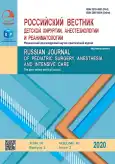De Castro falloplasty of the with penile agenesis
- Authors: Kagantsov I.M.1,2, Dubrov V.I.3, De Castro R.4
-
Affiliations:
- Pitirim Sorokin Syktyvkar State University
- Republican Children’s Clinical Hospital
- 2nd Children’s Hospital
- Centro di Chirurgia Hospital Petrucciani, Lecce, Italy
- Issue: Vol 10, No 2 (2020)
- Pages: 183-191
- Section: Case reports
- URL: https://journals.rcsi.science/2219-4061/article/view/122908
- DOI: https://doi.org/10.17816/psaic659
- ID: 122908
Cite item
Full Text
Abstract
Introduction. Penile agenesis (aphallia) is an extremely rare congenital disorder. At present, about 100 cases of the anomaly have been described around the world. The incidence of this congenital anomaly is estimated to be one case per 20–30 million births. One of the most commonly used reconstructive procedures today is the technique proposed by Roberto De Castro in 2007. In this article, we present a clinical case of aphallia in a boy who underwent phalloplasty.
Materials and methods. A newborn boy presented with aphallia, combined with abnormal development of both kidneys. At birth, the child had difficult urination through the fistula at the edge of the anus. The meatotomy and urethral dilation were performed on the fifth day of the infant`s life. On day 28 of the child`s life, surgical intervention was performed to remove the left non-functioning kidney and a right cutaneous ureterostomy because of the recurrence of febrile urinary tract infection. At 13 months, the tissue expander was installed above the pubic bone. At 16 months, the child underwent the De Castro phalloplasty technique while in the supine position.
Results. The child was examined 3, 6, and 12 months after the surgical treatment. Phalloplasty has had good outcomes as evaluated by parents and surgeons. At present, the boy is under the supervision of urologists, who plan to perform further surgical treatment of the urinary system.
Conclusion. Phalloplasty, in the case presented, had a good cosmetic result. In our opinion, it proved to be the correct initial stage of treatment for aphallia, an extremely rare genital malformation.
Keywords
Full Text
##article.viewOnOriginalSite##About the authors
Ilia M. Kagantsov
Pitirim Sorokin Syktyvkar State University; Republican Children’s Clinical Hospital
Author for correspondence.
Email: ilkagan@rambler.ru
ORCID iD: 0000-0002-3957-1615
Dr. Sci. (Med.), Professor at the Department of Surgical Diseases; Head of Department of Urology
Russian Federation, SyktyvkarVitalii I. Dubrov
2nd Children’s Hospital
Email: dubroff2000@mail.ru
ORCID iD: 0000-0002-3705-1288
SPIN-code: 5833-4928
Cand. Sci. (Med.), Head of the Department of Urology
Belarus, MinskRoberto De Castro
Centro di Chirurgia Hospital Petrucciani, Lecce, Italy
Email: decastro1610@gmail.com
ORCID iD: 0000-0001-7602-5560
Professor
Italy, LecceReferences
- Kane AD, Ngom G, Ndour O, Alumeti DM. Aphallia: A case report and literature review. Afr J Paediatr Surg. 2011;8(3):324-325. DOI: https://doi.org/10.4103/0189-6725.91675.
- Joshi A, Gross J, Thomalla JV. Congenital aphallia: review of pathogenesis and current treatment guidelines. Urology. 2015;86(2):384-387. DOI: https://doi.org/10.1016/j.urology.2015.04.031.
- Evans JA, Erdile LB, Greenberg CR, Chudley AE. Agenesis of the penis: Patterns of associated malformations. Am J Med Genet. 1999;84(1):47-55.
- Hendren WH. The genetic male with absent penis and urethrorectal communication: experience with 5 patients. J Urol. 1997;157(4):1469-1474. DOI: https://doi.org/10.1016/s0022-5347(01)65026-2.
- Oliveira DEG, da Cruz ML, Luquori R, et al. Neophalloplasty in boys with aphallia: a systematic review. J Pediatr Urol. 2016;12(1):19-24. DOI: https://doi.org/10.1016/j.jpurol.2015.10.003.
- De Castro R, Merlini E, Rigamonti W, Macedo A Jr. Phalloplasty and urethroplasty in children with penile agenesis: preliminary report. J Urol. 2007;177(3):1112-1117. DOI: https://doi.org/10.1016/j.juro.2006.10.095.
- Jack S Elder. In: Walsh PC, Retik AB, Vaughan ED Jr, Wein AJ, editors. Campbell’s Urology. 8th ed. Saunders: Elsevier Science; 2002. P. 2343–2345.
- Skoog SJ, Belman AB Aphallia: its classification and management. J Urol. 1989;141(3):589-592. DOI: https://doi.org/10.1016/s0022-5347(17)40903-7.
- Mirshemirani A, Khaleghnejad A, Pourang H, et al. Penile agenesis: report on 8 cases and review of literature. Iran J Pediatr. 2009;19(2):173-179.
- Raveenthiran V. Controversies of sex re-assignment in genetic males with congenital inadequacy of the penis. Indian J Pediatr. 2017;84(9):700-708. DOI: https://doi.org/10.1007/s12098-017-2412-3.
- Perovic SV, Djinovic R, Bumbasirevic M, et al. Total phalloplasty using a musculocutaneous latissimus dorsi flap. BJU Int. 2007;100(4):899-905; discussion 905. DOI: https://doi.org/10.1111/j.1464-410x.2007.07084.x.
- Djordjevic ML, Bumbasirevic MZ, Vukovic PM, et al. Musculocutaneous latissimus dorsi free transfer flap for total phalloplasty in children. J Pediatr Urol. 2006;2(4):333-339. DOI: https://doi.org/10.1016/j.jpurol.2006.05.003.
- Terrier J-É, Courtois F, Ruffion A, Journel NM. Surgical outcomes and patients’ satisfaction with suprapubic phalloplasty. J Sex Med. 2014;11(1):288-298. DOI: https://doi.org/10.1111/jsm.12297.
- Massanyi EZ, Gupta A, Goel S, et al. Radial forearm free flap phalloplasty for penile inadequacy in patients with exstrophy. J Urol. 2013;190(4 Suppl.):1577-1582. DOI: https://doi.org/10.1016/j.juro.2012.12.050.
- Gouvea J, Garrone G, da Cruz ML, et al. Penile prosthesis implantation in a patient with congenital aphallia treated using the De Castro technique 10 years previously. Is it feasible? J Pediatr Urol. 2015;11(5):287-288. DOI: https://doi.org/10.1016/j.jpurol.2015.05.022.
Supplementary files












